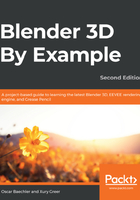
What this book covers
Chapter 1, Introduction to 3D and the Blender User Interface, explains the basics of Blender's interface, tools, and workflow conventions.
Chapter 2, Editing a Viking Scene with a Basic 3D Workflow, will take a look at a 3D scene and let us get used to navigating and transforming objects.
Chapter 3, Modeling a Time Machine – Part 1, is the beginning of a two-part project in which we will model an object based on provided reference images. We will cover many of the essential modeling tools needed for creating 3D objects.
Chapter 4, Modeling a Time Machine – Part 2, is the second half of the time machine project. We will build on our modeling knowledge and discover non-destructive workflows.
Chapter 5, Modern Kitchen – Part 1: Kitbashing, will show how to plan a complete scene and model the necessary assets to complete a kitchen layout.
Chapter 6, Modern Kitchen – Part 2: Materials and Textures, is a deep dive into material nodes and explains how to create all kinds of materials to decorate our kitchen with.
Chapter 7, Modern Kitchen – Part 3: Lighting and Rendering, is the final chapter in the kitchen series. We will produce a final rendered image complete with lighting and post-processing effects.
Chapter 8, Illustrating an Alien Hero with Grease Pencil, is the first of our three chapters that dives into the brand new feature set known as Grease Pencil. We will learn about character concept art workflows and how to use the basics of Grease Pencil.
Chapter 9, Animating an Exquisite Corpse in Grease Pencil, builds on the previous chapter's workflows and dives into animation and key frames with a loose and fun animation style.
Chapter 10, Animating a Stylish Short with Grease Pencil, wraps up the Grease Pencil projects in this book. We will cover more advanced workflows and explain how to animate something with more structure than the previous chapter.
Chapter 11, Creating a Baby Dragon – Part 1: Sculpting, is the beginning of the biggest project in this book. We'll start with an introduction to sculpting. We'll see an overview of the brushes and learn how to create our very own baby dragon design, which we will take all the way to a game-ready asset by the final chapter.
Chapter 12, Creating a Baby Dragon – Part 2: Retopology, is a shift into the more technical side of 3D character creation. We'll learn about shrink-wrapping, surface snapping, and rules of topology to transform the sculpted baby dragon into a low-poly mesh that can be used in a production pipeline.
Chapter 13, Creating a Baby Dragon – Part 3: UV Unwrapping, is where we'll prepare the model for texture painting. We'll learn how to cut seams, unwrap UVs, lay out islands, and use checker patterns to check for distortion.
Chapter 14, Creating a Baby Dragon – Part 4: Baking and Painting Textures, gets back to the artistic side of things. We'll start by baking texture maps that can be used as masks in our texture painting workflow. We'll use Blender's built-in texture painting tools, and we'll add some color and surface detail to the baby dragon.
Chapter 15, Creating a Baby Dragon – Part 5: Rigging and Animation, is the final baby dragon chapter. We'll get to see all of our hard work pay off and rig the dragon so that it can be posed and animated. To wrap it up, we'll animate a fly cycle so that we can see the character in action.
Chapter 16, The Wide World of Blender, shows off some of the areas that this book couldn't cover in detail. Even a book this size can barely scratch the surface of what a 3D suite such as Blender can do, but we'll have a look at some inspiring extra features before we're done.